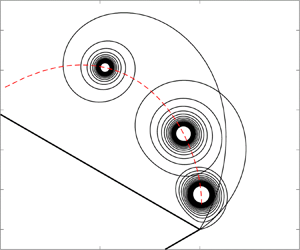Article contents
New insights from inviscid modelling of starting flow separation with roll-up
Published online by Cambridge University Press: 28 September 2020
Abstract

This paper investigates the use of inviscid flow theory accompanied by surfaces of discontinuity as a means of representing viscous effects. The problem studied is that of starting flow separation past a sharp wedge. We use the vortex-entrainment sheet model of DeVoria & Mohseni (J. Fluid Mech., vol. 866, 2019, pp. 660–688) to augment the set of self-similar solutions with zero entrainment as calculated by Pullin (J. Fluid Mech., vol. 88, 1978, pp. 401–430). Even under the constraints of similarity, the inclusion of entrainment allows for several new degrees of freedom, which correspond to different classes of boundary conditions, and thus solutions, that are excluded by classical potential models. Some computed examples are presented and compared to a previous experimental study. The results offer encouraging evidence that viscous or finite Reynolds number effects can, in an integrated sense, be captured by an inviscid model with singularity distributions. A normal boundary condition that contains the information pertaining to the entrainment must be supplied and represents the trade-off in surrendering the Navier–Stokes equations for the lower-order inviscid model.
JFM classification
- Type
- JFM Papers
- Information
- Copyright
- © The Author(s), 2020. Published by Cambridge University Press
References
REFERENCES
- 1
- Cited by



